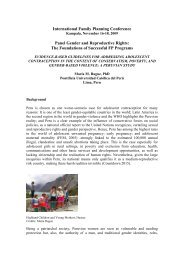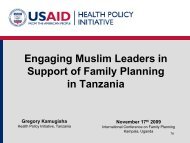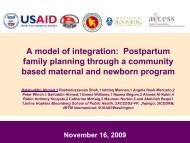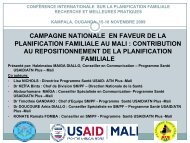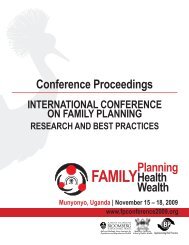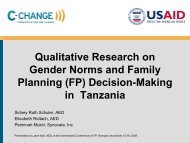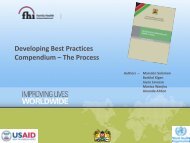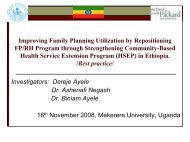Rationale for the National Family Planning Campaign - International ...
Rationale for the National Family Planning Campaign - International ...
Rationale for the National Family Planning Campaign - International ...
Create successful ePaper yourself
Turn your PDF publications into a flip-book with our unique Google optimized e-Paper software.
Unmet and Met Contraceptive<br />
Needs and Trends<br />
Designing a <strong>Family</strong> <strong>Planning</strong> <strong>Campaign</strong> <strong>for</strong> Rural<br />
Women in Zambia<br />
Dr. Reuben K. Mbewe, Ministry of Health, Zambia<br />
Uttara Bharath‐Kumar, Bharath Kumar, Health Communication Partnership, Zambia
Current FP situation in Zambia<br />
Demand‐side Demand side gaps include –<br />
concerns regarding side effects of<br />
modern methods,<br />
limited awareness of method<br />
choice (what, where and when to<br />
access methods),<br />
and desire <strong>for</strong> large families,<br />
especially among men.<br />
The mean ideal family size is 5.3<br />
children according to men<br />
compared to 4.7 <strong>for</strong> women (2007<br />
ZDHS)
What is <strong>the</strong> current situation with family<br />
planning in Zambia?<br />
Fertility is high and increasing, especially in rural<br />
areas ‐ TFR of 7.5 (ZDHS 2007)<br />
High umet need <strong>for</strong> family planning (27% of all<br />
married women) persists. (2007 ZDHS).<br />
When asked about <strong>the</strong> last baby <strong>the</strong>y had, 26% said<br />
<strong>the</strong>y had not wanted any more children and 16% said<br />
<strong>the</strong>y had wanted a child later, not <strong>the</strong>n. So effectively<br />
<strong>for</strong> 42% of women, <strong>the</strong>ir last baby was unplanned.
Current Situation –<br />
Current contraceptive prevalence is 33%<br />
Maternal mortality ratio 591/100000 live births<br />
cont.<br />
Unsafe abortion due to unplanned pregnancies is one of<br />
<strong>the</strong> major causes of mortality
Barriers to FP uptake<br />
2007 Zambia DHS found that method‐related method related concerns<br />
are <strong>the</strong> second most common reason <strong>for</strong> NOT using FP<br />
(second to fertility related reasons.)<br />
These include:<br />
fear of side effects,<br />
health concerns,<br />
belief that methods interfere with <strong>the</strong> body’s body s normal<br />
processes etc.<br />
In o<strong>the</strong>r words, we have more than anecdotal evidence<br />
that <strong>the</strong>re are concerns about <strong>the</strong> safety, efficacy and<br />
side effects of modern methods
FP Communication Working Group<br />
The Ministry of Health called upon partners<br />
involved in <strong>the</strong> area of reproductive health to<br />
brainstorm what needed to be done to address<br />
<strong>the</strong>se issues.<br />
Toge<strong>the</strong>r this committee came up with a creative<br />
brief that contained <strong>the</strong> following critical points<br />
that <strong>the</strong> campaign should address.
Existing tools<br />
Clinic tools <strong>for</strong> health providers:<br />
<strong>Family</strong> planning counseling kit<br />
Wall chart of contraceptive methods<br />
<strong>Family</strong> planning technical handbook<br />
Glossary of sexual and reproductive<br />
health terms in 7 Zambian languages
For <strong>the</strong> community:<br />
Existing tools<br />
Action <strong>for</strong> Health with Sister Evelina‐ Evelina<br />
radio programme (3 out of 26<br />
episodes on FP)<br />
Community Health In<strong>for</strong>mation Cards<br />
Our <strong>Family</strong>, Our Choice (video,<br />
discussion guide and booklets)
Communication Gaps?<br />
While <strong>the</strong>se tools helped support facility‐level facility level and<br />
community‐level community level health educators.<br />
At a national level, <strong>the</strong>re was an absence of<br />
reminders about and discussions around family<br />
planning.
To contribute to<br />
increases in modern<br />
contraceptive use<br />
among Zambian<br />
women, with a<br />
particular focus on<br />
underserved rural<br />
communities.<br />
<strong>Campaign</strong> Goal
What is needed?<br />
In this context,<br />
Ministry of Health and<br />
partners wished to<br />
redouble ef<strong>for</strong>ts to<br />
expand access to and<br />
create in<strong>for</strong>med<br />
demand <strong>for</strong> family<br />
planning.<br />
Particular attention<br />
would be paid to rural<br />
audiences
Communication Objective<br />
Increase approval and use of modern family<br />
planning methods, especially in <strong>the</strong> rural areas.<br />
Promote positive images of empowered women<br />
and supportive spouses<br />
Revitalize <strong>the</strong> national family planning logo to<br />
tie campaign materials toge<strong>the</strong>r and raise public<br />
awareness of family planning.
Key Benefits to be Communicated<br />
Modern Methods: Modern family planning methods<br />
are safe and effective <strong>for</strong> women to use.<br />
<strong>Family</strong> <strong>Planning</strong>: is when a couple decides when, how<br />
many and at what intervals <strong>the</strong>y want to have<br />
children.<br />
Helps <strong>the</strong> mo<strong>the</strong>r and children be healthier as <strong>the</strong>y<br />
have more time to recover <strong>the</strong>ir health and grow<br />
well, respectively<br />
Helps <strong>the</strong> family manage its available resources so<br />
<strong>the</strong> children <strong>the</strong>y have planned can grow well and<br />
be educated.
Concept outlines<br />
Concept 1: Married women (a group of<br />
peers discuss among <strong>the</strong>mselves)<br />
A group of women talk about and<br />
reveal challenges of large family,<br />
closely spaced children. One<br />
declares she is using FP. O<strong>the</strong>rs talk<br />
of some myths and fears.<br />
Safety, effectiveness of modern FP<br />
methods – reassuring <strong>the</strong> women
Concept 2: Men<br />
Concept outlines<br />
Two men discuss <strong>the</strong> issue of one<br />
having too many children and <strong>the</strong><br />
o<strong>the</strong>r with only one/two/three.<br />
Small family man’s man s wife is using a<br />
modern method.<br />
Myths and fears like concern about<br />
wife’s wife s unfaithfulness etc (addresses<br />
<strong>the</strong>m)<br />
Shows how men can be supportive<br />
of <strong>the</strong>ir partners using a modern<br />
method while still ‘being being a man’.<br />
man
Concept outlines<br />
Concept 3: <strong>Family</strong> <strong>Planning</strong> is <strong>for</strong> All<br />
(Young, married woman and a<br />
service provider)<br />
Enjoy <strong>the</strong>ir early married life<br />
toge<strong>the</strong>r. Support to resist<br />
pressure from family to<br />
immediately have a baby. They<br />
are still young and can delay <strong>the</strong><br />
birth of <strong>the</strong>ir first child.
Call to Action<br />
<strong>Family</strong> planning<br />
methods are safe<br />
and <strong>the</strong>y work! Go<br />
to your nearest<br />
health centre and<br />
learn more about<br />
how you can<br />
choose <strong>the</strong> family<br />
planning method<br />
that is best <strong>for</strong> you.
Creative considerations<br />
In <strong>the</strong> 2007 ZDHS:<br />
74% of men and 59% of women listen to<br />
<strong>the</strong> radio and 37% of men and 31% of<br />
women watch television.<br />
Missed opportunities: six in ten men and<br />
women of ages 15‐19 15 19 had not heard of<br />
family planning in <strong>the</strong> media.
Creative considerations<br />
Where <strong>the</strong>y did get<br />
in<strong>for</strong>mation about<br />
family planning at<br />
all, radio was cited<br />
as <strong>the</strong> most<br />
important source of<br />
family planning<br />
in<strong>for</strong>mation and<br />
television next
Multi‐media Multi media approach<br />
Given <strong>the</strong> increasing exposure of rural areas to<br />
television and radio (community radio in particular),<br />
electronic media was seen as a key part of <strong>the</strong><br />
campaign.<br />
Literacy is not high among rural women so <strong>the</strong>y was<br />
need <strong>for</strong> very pictorial and easy‐to easy to‐read read posters in<br />
<strong>the</strong> clinic waiting rooms and community centres<br />
that serve as reminders about family planning.
Channels<br />
5000 health care provider buttons that say “Talk Talk to me<br />
about <strong>Family</strong> <strong>Planning</strong>” <strong>Planning</strong> with <strong>the</strong> FP logo<br />
3 short television spots (English + 7 Zambian languages)<br />
3 short radio spots: (5 minutes each): Spots on TV and<br />
radio in English + 7 Zambian languages (<strong>for</strong> broadcast<br />
on ZNBC, community radio stations, o<strong>the</strong>r TV<br />
stations, ZANIS)<br />
Posters: Simple and pictorial. Each of <strong>the</strong> posters<br />
reflect <strong>the</strong> message from each of <strong>the</strong> three TV/Radio<br />
spots.<br />
Posters:<br />
Booklet: Based on <strong>the</strong> “Our Our <strong>Family</strong>, Our Choice” Choice all‐ all<br />
methods booklet<br />
Booklet:
From Brief to <strong>Campaign</strong><br />
With <strong>the</strong> creative brief in place and <strong>the</strong> channels<br />
selected, Health Communication Partnership<br />
Zambia, one of <strong>the</strong> members of <strong>the</strong> FP<br />
Communication Working Group, was tasked with<br />
turning <strong>the</strong> creative brief into a campaign.<br />
Launched in late August, exposure and effects of<br />
this campaign will be evaluated by MOH and<br />
partners in <strong>the</strong> next six months to a year.
Percent of women currently using a modern contraceptive method, by<br />
exposure to Our <strong>Family</strong> Our Choice<br />
video and VCT services in past 12<br />
months<br />
Source: 2009 Zambia HCP Endline Survey (n=1,765)<br />
Controlling <strong>for</strong> Age, Education, Urban residence, Parity, and perceived spousal approval of FP



